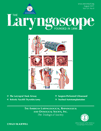The cochleovestibular nerve identified during auditory brainstem implantation in patients with narrow internal auditory canals: Can preoperative evaluation predict cochleovestibular nerve deficiency?†‡
This study was supported by a grant of the Korea Healthcare Technology R&D Project, Ministry for Health, Welfare & Family Affairs, Republic of Korea (A090200).
The authors have no conflicts of interest to disclose.
Abstract
Objectives/Hypothesis:
To analyze the value of preoperative diagnostic tools in predicting the status of the cochleovestibular nerve (CVN) in patients with narrow internal auditory canals (IAC).
Study Design:
Retrospective case series at a tertiary hospital.
Methods:
Eight profoundly deaf patients with narrow IACs who received auditory brainstem implantation were included in this study. The results of preoperative imaging, electrophysiologic, and auditory tests were correlated with the CVN status identified during auditory brainstem implantation.
Results:
Temporal bone computed tomography (CT) findings, including the patency of the bony cochlear nerve canal and the diameter of the IAC, were limited in accurately reflecting the status of the CVN. Magnetic resonance imaging (MRI) and preoperative auditory responses to either pure tone or environmental sounds were more accurate markers for detecting the presence of a CVN than CT; however, there were limitations in cases with a very thin CVN or combined severe mental retardation. Absence of promontory or intracochlear electrically evoked auditory brainstem responses were not always indicative of an absent CVN.
Conclusions:
Visualization on MRI and detection of auditory responses suggested the presence of a CVN in patients with narrow IACs; however, the possibility of the presence of a CVN should be considered even when there is no clear evidence of a CVN on preoperative evaluations. Therefore, physicians should be prudent when determining candidacy for cochlear implantation or auditory brainstem implantation in patients with narrow IACs.




